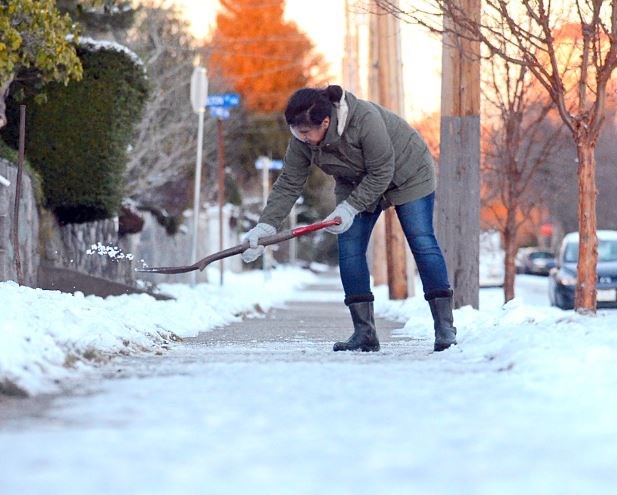New Westminster may embark on a “bold” new path that prioritizes pedestrian and cyclist routes in the winter months.
City council recently received a staff update on the city’s snow and ice response preparations. In the fall of 2017, council endorsed a four-point snow and ice response plan that prioritizes which streets to tackle first, but also directed staff to work on developing a snow response plan that prioritizes pedestrian safety and addresses the concerns raised by the city’s advisory committee for transit, bicycles and pedestrians.
Coun. Patrick Johnstone believes the city may need to “rethink the entire idea of how we do snow removal” and put more emphasis on cyclists and pedestrians because the focus on roads isn’t consistent with the city’s master transportation plan, the age-friendly strategy and accessibility goals. He said the city invests its limited resources into plowing and sanding of roads but relies on the neighbourliness of residents and businesses to ensure pedestrian spaces are safe for travel.
“We are required to keep roads clear for a variety of safety reasons, not the least being emergency access and transit access,” he said. “I also recognize this would be a significant change in how we plan for snow removal, but I think it’s time.”
While the city isn’t necessarily going to have a 10- or 12-hour response time to clear 250 kilometres of sidewalks in New Westminster, Johnstone said the city can prioritize routes that need to be cleared.
“We can, much like our roads, prioritize routes,” he said. “We can make a decision about how many resources we can afford to put in so we can prioritize routes and make sure certain areas are safe for pedestrians. My point is, I think it’s time for the city to discuss whether we take responsibility for it.”
Council approved a motion to have staff report back on costs and other implications related to shifting the city’s practice to include having the city provide snow removal of priority pedestrian and transit-servicing areas.
“I think it’s an interesting idea. I would like to see what staff can bring back to us,” said Coun. Mary Trentadue. “I think of the many people in our community that need to access the sidewalks and can’t for various reasons in the winter. I think of the seniors that can’t, or others, take care of the sidewalks in front of their homes and how does that work out for the rest of the community.”
Trentadue said some people are still unaware that it’s their responsibility to clear sidewalks of snow and suggested the city may need to get the word out earlier. (The city’s street and traffic bylaw requires property owners and occupants to remove snow and ice from sidewalks abutting their property by no later than 10 a.m. of the day following a snowfall event.)
“I have conversations with people about their sidewalks. Many, many people don’t realize it is their responsibility,” she said. “I think once the snow hits it’s too late for us to try and tell people.”
Coun. Nadine Nakagawa supports the city exploring this “really bold” direction for snow and ice response.
Under the plan endorsed by council in October 2017, here are the priorities for snow removal:
* Priority 1: Arterial streets, roads providing major access for emergency vehicles and primary care facilities, and major roads with steep hills. At least two lanes will be plowed, salted and sanded as needed during the snowfall and cleared within 24 hours after the end of snowfall.
* Priority 2: Major collectors, bus routes and rapid transit stations, schools along steep hills and arterial bike routes. At least two lanes will be plowed, salted and sanded as needed, within 48 hours after the end of snowfall.
* Priority 3: Neighbourhood collectors, major civic facilities and schools in flat areas. These routes will be done within 24 hours after Priority 2 routes are complete.
* Priority 4: Local routes, only-access lanes for vehicles and solid waste collection. These will be done within 24 hours after Priority 3 routes are complete.



